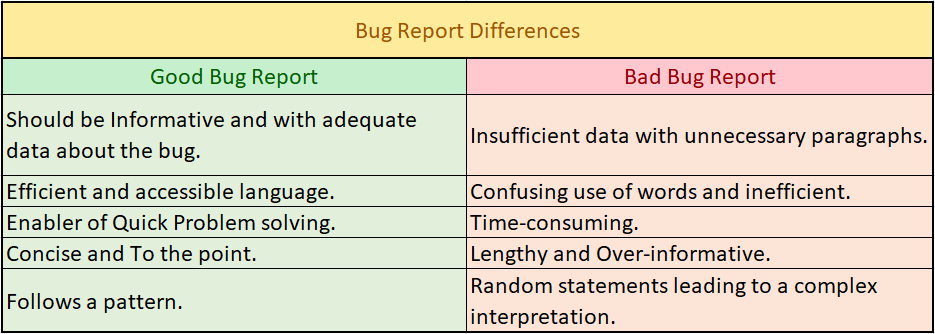Definition, Importance, and Methodology of a Good Bug Report

In the vigorous process of testing software, if one doesn’t work with proper planning and efficient shortcuts, the whole thing can be chaotic. Reporting the bugs and errors found after the execution of the test is one of the crucial steps in the whole process. Communication wise it is one of the prominent parts of the process.
The correction of the bugs by the developers solely depends on the way the bugs are reported in the bug report. The report needs to be concise and should convey the information effectively.
Here, we discuss all the elements of creating an effective Bug report.
Defining Bug and Bug ReportA Bug in software is an error in code due to which an unexpected effect takes place in the behavior of the software.
Most bugs arise from mistakes and errors made in either a program’s design or its source code, or in components and operating systems used by such programs. While some are caused by compilers producing incorrect code.
The testing team detects these bugs and reports it to the developers’ team to take corrective measures. This reporting is done by a document called a Bug report.
The bug report is a document produced by a tester for a developer which consists of the information related to the bug in question and necessary steps and data about the reproduction of the bug.
Difference between a Good Bug Report and Bad Bug ReportTo make it easy for you, we created a concise table to understand what are the differences between a good bug report and a bad one.

Every bug report might have its conditions but some factors are to be considered while writing a good bug report. Below are some aspects of it which can be included in it.
- Reporter: Your name and email.
- Product: Name of the application in which you found this bug.
- Version: Version of the application if any.
- Components: Components of the application.
- Platform: Name of the platform in which you found this bug, such as PC or Mac.
- Operating System: Operating system in which you found this bug such as Windows, Mac OS, or Linux.
- Priority: This state how important the bug is and how urgent the bug should be fixed. You can do it by assigning values like #P1 to #P5. With ascending from most important to less.
- Severity: The effect of the bug in the application. What the bug is doing to the application and when and how is it affecting. There are different ways in which it can happen,
- Blocker: Restricting for further testing
- Critical: crashing of application
- Major and Minor: loss of functions
- Trivial: Needs UI improvement
- Enhancement: Need a new or addition of a feature
- Status: The status of the bug. In the process, verified or fixed.
- Assign To: Information about the developer who was accountable for the bug in question. If you don’t know this, Specify the email address of the manager.
- URL: URL of the particular bug found in the application.
- Summary: A summary of the report is not more than 70 words. Add:
- Reproduction Steps: Precise steps to reproduce the bug.
- Expected Result: The expected result of the application.
- Actual Result: Actual result obtained while testing.
- Report Types: This is an optional mention.Various types of reports can be mentioned like Coding error, design error or documentation issue, etc.
Some of the prominent features of the bug report are listed below. Make sure to add these to your report.
- Bug ID: To make it more accessible, you can assign a number to each of the bugs which will be unique of its own. By doing this you can easily check on the status of the bug anytime, anywhere.
- Bug Title: Giving a title to the bug can help easily guess what the bug is about. A keyword of sorts. It should be concise, easy to understand, and relatable. The developer should quickly catch up on it and it should smoothly convey the crux of the bug.
- Environment: It should be mentioned that in which environment the bug is found by the tester. It saves a lot of work of the developers and makes it easy for them to access the bug and solve it in the respective environment and/or platform.
- Description: This is the main part. All the information about the bug should be included in the description. This should be precise and informative and not confusing.It is a good habit if you report every bug separately as the confusion gets lessened.
- Steps of Reproduction: Accurate information about the bug and the proper steps about how to reproduce the bug should be mentioned here. This information is helpful to the developing team. Every step should be precisely specified in this section.
- Proof: Some sort of proof or demo should be given in the report that should prove the developers that the bug you mentioned is valid and real. Taking a screenshot or recording the screen might be helpful.
Write the bug report as soon as you find the bug. Don’t procrastinate as you might forget things later.
- Reproduce the bug yourself 3 to 4 times. This will help in writing the reproduction steps and the bug will get confirmed.
- Write a good bug summary in the bug report. This way the developer can easily understand the bug and can work on it.
- Proofread your bug and remove unnecessary information.
- Do not criticize the developer for creating the bug and do not feel powerful upon finding it in the first place. It is not healthy.
We hope this blog helped you in some or the other way. You must write a fine bug report to enhance the whole process of software development and testing. As a tester, it is your responsibility to make the effort to convey the bug report suitably.
How can VTEST helpVTEST works efficiently and precisely towards the fineness of the application. For the test to get success without any obstacle, our testing team works in a way that is communicative, smooth, and easy to understand by all the members working on the project.
Good communication and fine grip over the language are the necessities to produce a good bug report. VTEST provides both of these qualities in a diligent manner.
Don’t just Test, Let’s VTEST

About VTEST
VTEST is an independent software testing company catering to product and service teams across the globe. We are a team of software testers who are passionate about quality and love to test. We develop an in-depth understanding of the applications under test and include software testing services strategies that deliver quantifiable results.
In short, we help in building incredible software.



